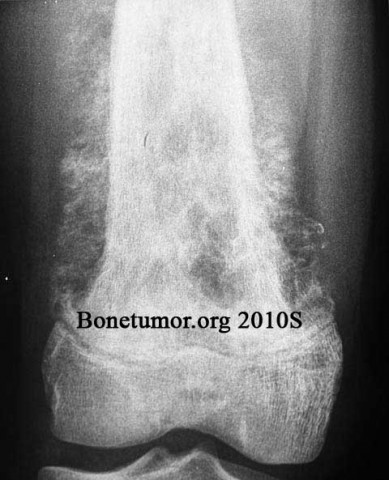Case Identification
Case ID Number
Tumor Type
Body region
Benign or Malignant
Clinical case information
Case presentation
A 14 year old boy presents with pain and a mass above the knee.
Radiological findings:
Take a look at the AP and lateral radiographs first. Notice the extensive periosteal reaction. This pattern has been described as a "sunburst" appearance. Next take a look at at AP and lateral radiographs of the whole distal femur. What this case demonstrates is the relative "balance" or proportion between the volume of intraosseous abnormality and the volume of extraosseous abnormality. What I hope you can see is there seems to be about the same amount of tumor inside as outside the bone.
Differential Diagnosis
Osteosarcoma vs Ewing sarcoma
Treatment Options:
This patient is currently undergoing preoperative evaluation and will receive neoadjuvant chemotherapy. Ultimately he will need surgical treatment of one sort or another.The ultimate decision about what to do for this extremely challenging surgical problem will depend on the clinicopathologic stage of the tumor, the patient's response to treatment, and discussions with the patient and family.
Special Features of this Case:
This case is an osteosarcoma. The point here is to demonstrate the radiographic appearance of the tumor and to hint at the characteristic balance between the amount of tumor inside and outside the bone that may be seen in osteosarcoma. Why do we care? Because these features might help distinguish this tumor from the other tumor that is likely in this patient and this location, Ewing's sarcoma.
As it happens, Ewing's sarcoma usually does not have this type of periosteal reaction. Ewing's may also have a much more "lopsided" appearance. There may be a small intraosseous tumor and a large soft tissue mass. In fact, the abnormality within the bone may be minimally visible in Ewing's tumor even while the mass outside the bone is very large.
Bone tumors do not follow the "rules" and they do not always look they way they "should". Nevertheless, this case might help you decide between an osteosarcoma and a Ewing's tumor someday.
As it happens, Ewing's sarcoma usually does not have this type of periosteal reaction. Ewing's may also have a much more "lopsided" appearance. There may be a small intraosseous tumor and a large soft tissue mass. In fact, the abnormality within the bone may be minimally visible in Ewing's tumor even while the mass outside the bone is very large.
Bone tumors do not follow the "rules" and they do not always look they way they "should". Nevertheless, this case might help you decide between an osteosarcoma and a Ewing's tumor someday.
Imagen

Secret Tumor Name
Case ID Number
Image Types
Image modality
Tumor Name
Benign or Malignant









